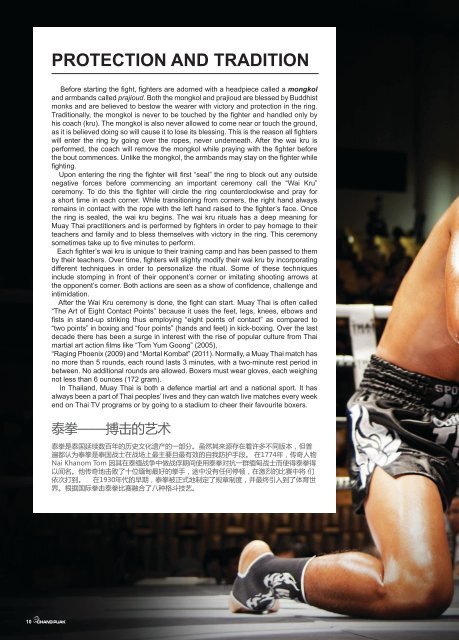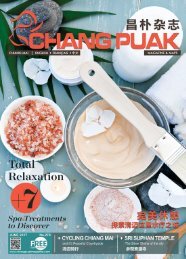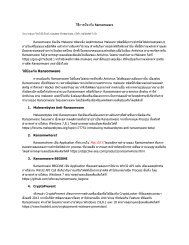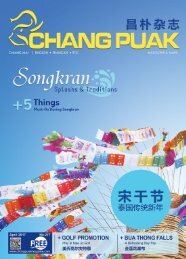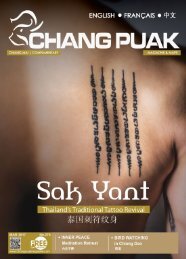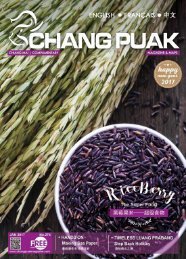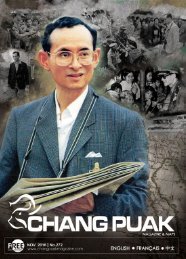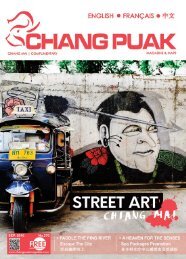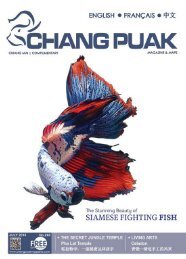You also want an ePaper? Increase the reach of your titles
YUMPU automatically turns print PDFs into web optimized ePapers that Google loves.
PROTECTION AND TRADITION<br />
Before starting the fight, fighters are adorned with a headpiece called a mongkol<br />
and armbands called prajioud. Both the mongkol and prajioud are blessed by Buddhist<br />
monks and are believed to bestow the wearer with victory and protection in the ring.<br />
Traditionally, the mongkol is never to be touched by the fighter and handled only by<br />
his coach (kru). The mongkol is also never allowed to come near or touch the ground,<br />
as it is believed doing so will cause it to lose its blessing. This is the reason all fighters<br />
will enter the ring by going over the ropes, never underneath. After the wai kru is<br />
performed, the coach will remove the mongkol while praying with the fighter before<br />
the bout commences. Unlike the mongkol, the armbands may stay on the fighter while<br />
fighting.<br />
Upon entering the ring the fighter will first “seal” the ring to block out any outside<br />
negative forces before commencing an important ceremony call the “Wai Kru”<br />
ceremony. To do this the fighter will circle the ring counterclockwise and pray for<br />
a short time in each corner. While transitioning from corners, the right hand always<br />
remains in contact with the rope with the left hand raised to the fighter’s face. Once<br />
the ring is sealed, the wai kru begins. The wai kru rituals has a deep meaning for<br />
Muay Thai practitioners and is performed by fighters in order to pay homage to their<br />
teachers and family and to bless themselves with victory in the ring. This ceremony<br />
sometimes take up to five minutes to perform.<br />
Each fighter’s wai kru is unique to their training camp and has been passed to them<br />
by their teachers. Over time, fighters will slighty modify their wai kru by incorporating<br />
different techniques in order to personalize the ritual. Some of these techniques<br />
include stomping in front of their opponent’s corner or imitating shooting arrows at<br />
the opponent’s corner. Both actions are seen as a show of confidence, challenge and<br />
intimidation.<br />
After the Wai Kru ceremony is done, the fight can start. Muay Thai is often called<br />
“The Art of Eight Contact Points” because it uses the feet, legs, knees, elbows and<br />
fists in stand-up striking thus employing “eight points of contact” as compared to<br />
“two points” in boxing and “four points” (hands and feet) in kick-boxing. Over the last<br />
decade there has been a surge in interest with the rise of popular culture from Thai<br />
martial art action films like “Tom Yum Goong” (2005),<br />
“Raging Phoenix (2009) and “Mortal Kombat” (2011). Normally, a Muay Thai match has<br />
no more than 5 rounds, each round lasts 3 minutes, with a two-minute rest period in<br />
between. No additional rounds are allowed. Boxers must wear gloves, each weighing<br />
not less than 6 ounces (172 gram).<br />
In Thailand, Muay Thai is both a defence martial art and a national sport. It has<br />
always been a part of Thai peoples’ lives and they can watch live matches every week<br />
end on Thai TV programs or by going to a stadium to cheer their favourite boxers.<br />
泰 拳 —— 搏 击 的 艺 术<br />
泰 拳 是 泰 国 延 续 数 百 年 的 历 史 文 化 遗 产 的 一 部 分 。 虽 然 其 来 源 存 在 着 许 多 不 同 版 本 , 但 普<br />
遍 都 认 为 泰 拳 是 泰 国 战 士 在 战 场 上 最 主 要 且 最 有 效 的 自 我 防 护 手 段 。 在 1774 年 , 传 奇 人 物<br />
Nai Khanom Tom 因 其 在 泰 缅 战 争 中 做 战 俘 期 间 使 用 泰 拳 对 抗 一 群 缅 甸 战 士 而 使 得 泰 拳 得<br />
以 闻 名 。 他 传 奇 地 击 败 了 十 位 缅 甸 最 好 的 拳 手 , 途 中 没 有 任 何 停 顿 , 在 激 烈 的 比 赛 中 将 们<br />
依 次 打 到 。 在 1930 年 代 的 早 期 , 泰 拳 被 正 式 地 制 定 了 规 章 制 度 , 并 最 终 引 入 到 了 体 育 世<br />
界 。 根 据 国 际 拳 击 泰 拳 比 赛 融 合 了 八 种 格 斗 技 艺 。<br />
10


